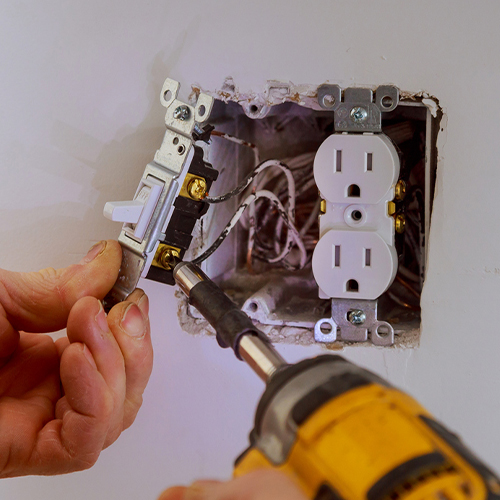Why Homeowners Call Rhema
Common Questions About Electrical Switches & Outlets
When a switch is connected to a breaker or safety device, it can trip to protect your home. This happens when:
- Circuits are overloaded: Too many devices on one circuit draw more power than the system can handle.
- Wires short out: A hot wire touches a neutral or ground wire, causing a surge.
- Faulty wiring or appliances: Loose wires or damaged devices can trigger a safety shut-off.
- Ground faults: Electricity escapes its intended path and touches a grounded surface.
Frequent tripping means something isn’t right. We can trace the cause and fix the issue before it becomes a hazard.
Thermosetting plastics such as Bakelite or melamine are commonly used in electrical switches because of their ability to withstand high temperatures without melting. This helps maintain the stability of the switch during extended or heavy use. These materials also insulate electricity effectively, lowering the risk of electrical shock, and they are naturally flame-resistant, which enhances the overall safety of the device.
In addition to these protective properties, thermosetting plastics are strong and durable, allowing switches to remain reliable and intact even after years of regular use.
Several switch types are used in homes, each with a different job:
- Single-pole: One switch controls one light or device
- Double-pole: Often used for 240V appliances like dryers or water heaters
- Three-way: Lets you control one light from two locations
- Four-way: Adds a third or fourth control point to a circuit
- Dimmer: Adjusts light intensity
- Smart switches: Controlled by phone apps or voice assistants
- Toggle, rocker, push-button: Different styles for how the switch feels and functions
We’ll help you choose the right type based on your space and goals.
Outlet placement follows safety code and practical use. Here’s what most homes need:
- Living rooms and bedrooms: Outlets every 6–12 feet along the wall
- Kitchens: GFCI outlets above counters, no more than 24 inches apart
- Bathrooms: GFCI outlet within 3 feet of the sink
- Hallways: At least one if longer than 10 feet
- Garage and outdoor areas: GFCI protection required
- Basements: Outlets placed for access, moisture-safe if unfinished
We’ll make sure every outlet follows code and fits how you use each room.
Yes, electrical outlets can wear out or become unsafe over time. Signs of a failing outlet include loose plugs that no longer stay in place, sparking when plugging in devices, faceplates that feel warm to the touch, burn marks or discoloration, and intermittent power or frequent breaker trips.
These issues can be caused by age, moisture, wiring problems, or damaged internal parts. If you’re unsure whether your outlet is safe, we can inspect it and replace it if needed.

